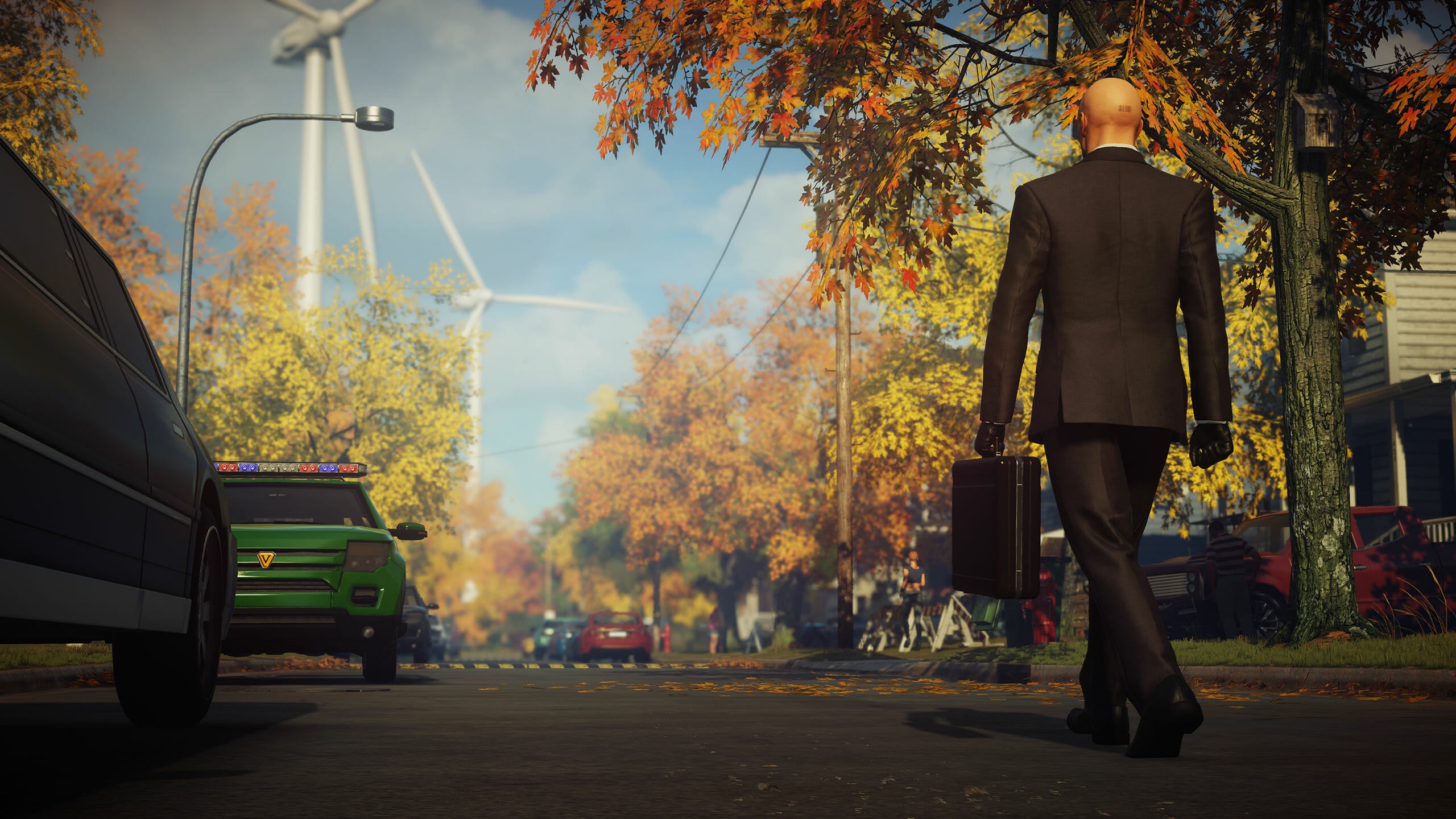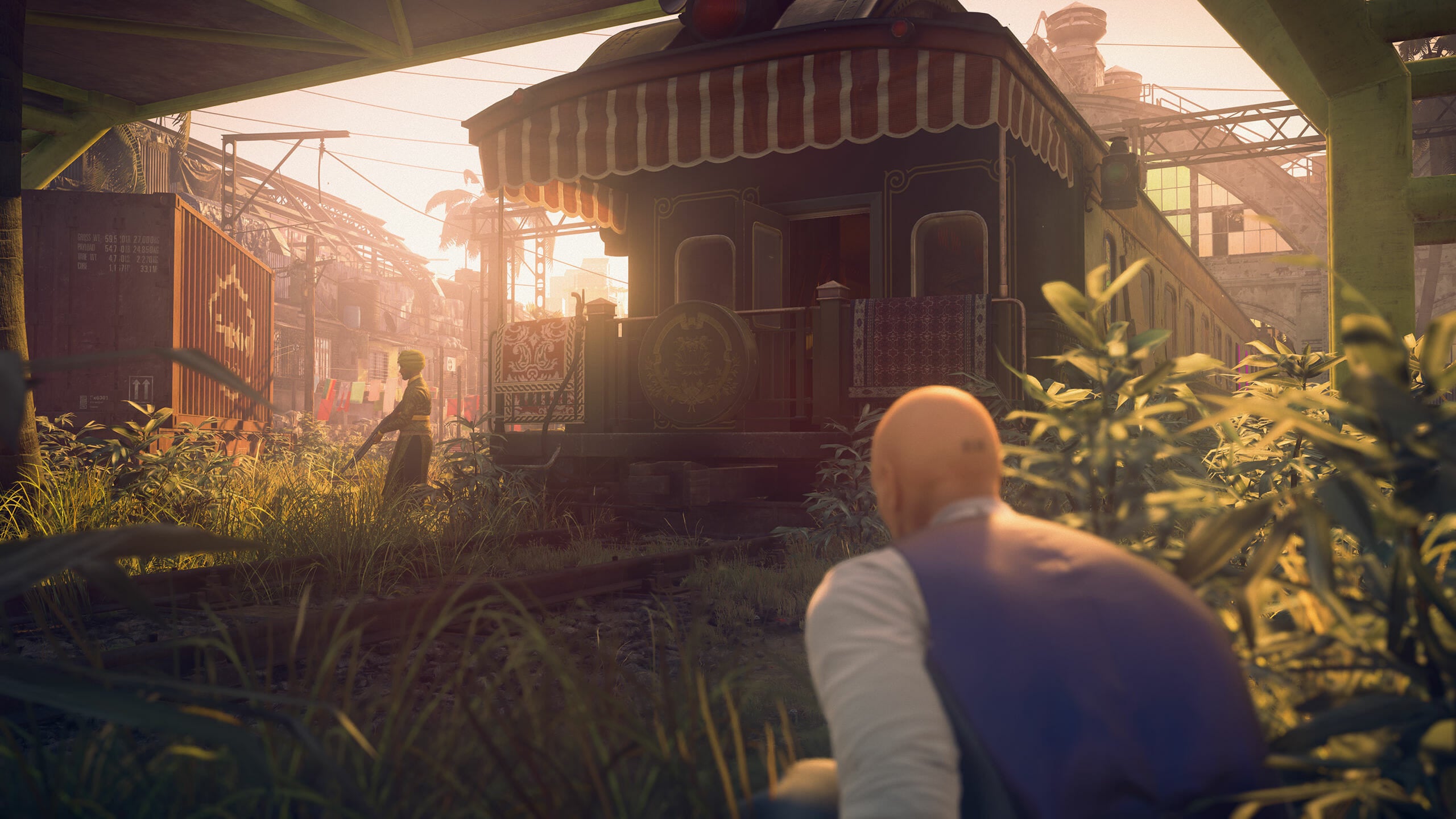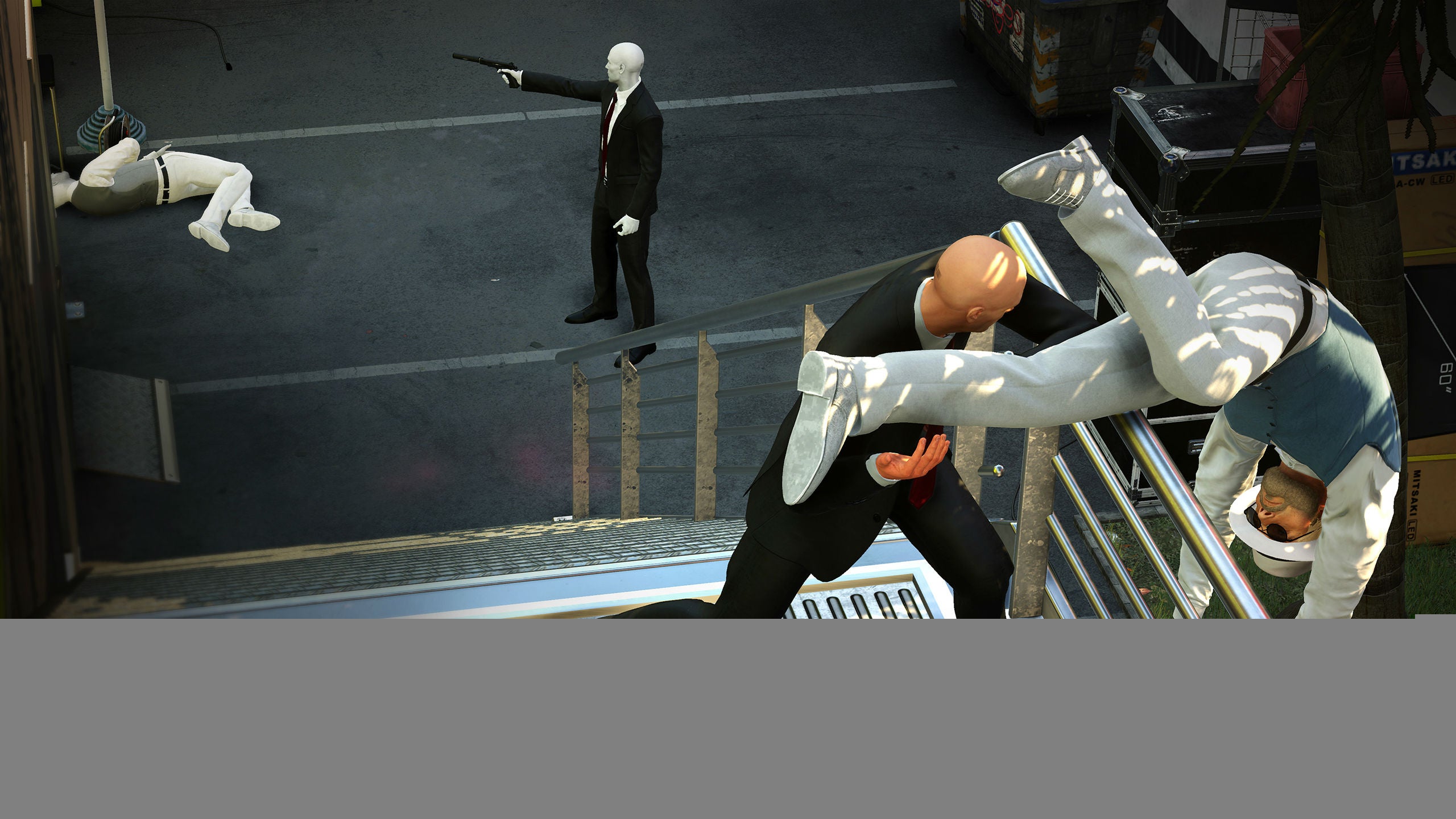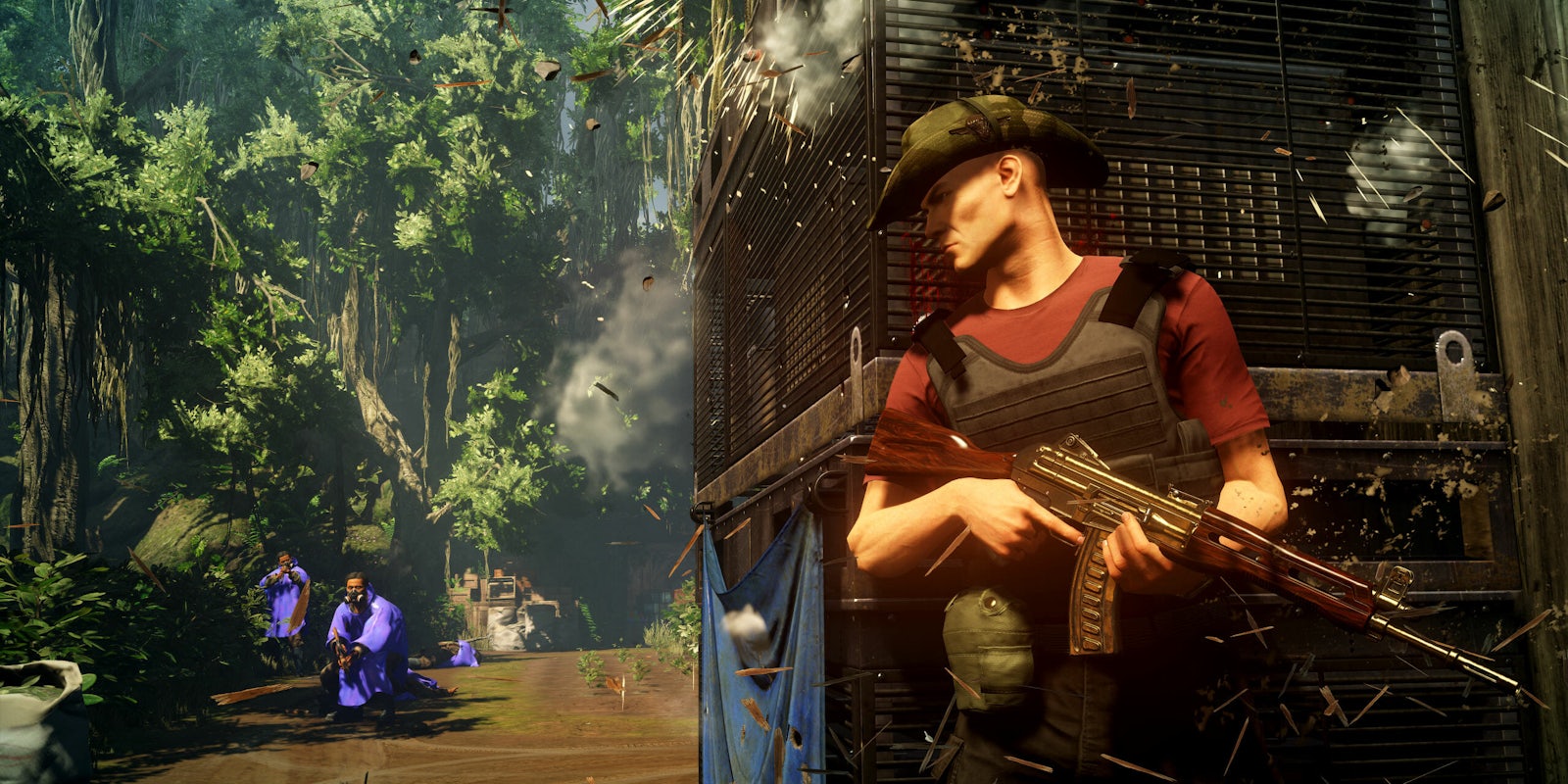Who can blame the poor old man for wanting to escape into a nearby alley for some privacy? After all, a sharp-tongued messenger from the leader of a local gang had only just beaten on his business’ door demanding an answer: Will the elderly tailor agree to make a dress beautiful enough to honor the lady crime lord? Though the presence of his sons warded off the intruder for now, they never accounted for a third, far more capable party: the one known as Agent 47 in the world of Hitman 2.
Slinking among the droves of tourists and evening bazaar window shoppers, I closed in quickly. This was my chance. Take the tailor out as quietly as possible, assume his identity, and find a way into the good graces and tender neckline of my target. The old man had pulled out his phone, begging a colleague for advice. He never even heard me as I wrapped my arms around his throat in an unrelenting chokehold—a perfect maneuver by the perfect assassin… at least until the shocked gasp of a random civilian behind me echoed through the streets.
I didn’t understand. I had surveilled, I had waited, I had pounced in such glorious fashion, only to draw the attention of damn near everyone around me, the tailor’s body not yet limp.
Classic Hitman.
In 2016, the Hitman series arose from the (somewhat) dead, with a fresh reboot and a plain title. Hitman! It had managed to both modernize and increasingly gamify a series that had been verging on the uncomfortably aimless and borderline sexist. (Remember the sexy machine gun-wielding nuns? Now you do. Sorry.) Regardless, 2016’s Hitman saved the franchise from the bargain bin, emphasizing replayability, open-ended player choice, and a save system that graciously allowed experimentation. This was all on top of sprawling, beautiful levels that left enough room for extra missions to be added later in the year, dramatically expanding Hitman’s lifespan.
Then the worst happened. Despite the overwhelmingly critical success, Square Enix ended its partnership with developer IO Interactive, putting the future of the series (and the rights to it) in question. The rebirth of a franchise focused on assassination was almost itself snuffed out. Two years later, and certainly in a different format than IO probably intended, Hitman 2 comes to us like a phoenix from the ashes—a bit charred at the edges, but no less spectacular.
Really, though, the word “Season” ought to fall between the words Hitman and 2. After all, this is no major reshaping of the franchise; there are no major mechanical, graphical, or stylistic changes. This is literally more Hitman, and that’s the beauty of it. Where uncertainty comes into play is just how Hitman 2 will be supported over the next year, considering it’s a full package of five levels (and some extra modes) all at once, rather than the slow drip of its predecessor.

First, the obvious: If you loved Hitman, the sequel will scratch that itch the way only the iconic cueball killer can. Following the events of the 2016 reboot, Agent 47 is on the track of a shadowy client who turns out to be a former “brother” of sorts from the organization that gave birth to their assassin skill set, culminating in the reveal of a revenge plot against that same group. Over the course of Hitman 2’s five main missions, Agent 47 and his coolheaded handler, Diana, manage to confront this “brother” and spark off a quest for answers about 47’s past.
If that sounds a little droll, well, that’s because it is. It’s the stuff any number of Tom Clancy and John le Carré novels are made of: cutthroat spies, backstabbing grudges, and global string-pullers running the show. If there’s one spot where the backing of Square Enix’s bank account is noticeably missing, it’s Hitman 2’s lack of animated cutscenes. Hitman’s cinematics, brief and unimportant as they were, were impeccably rendered and moody. Hitman 2 saves a buck by opting for freeze-frame interludes, more comic-like in nature, but all voiced by the same principal actors. It does the job, and no one is really here to see the way 47’s eyebrows wiggle, but it’s a shortcoming compared to the last game.
Save for a few moments in the latter half of Hitman 2, it’s all a humorously detached vehicle for the real star of the show: the laughable (and often bloody) ways you’ll dispatch of your targets, whose connections to the actual plot are hardly memorable.
The kills are as hilarious and absurd as the disguises 47 shimmies his way into. What does it matter that the infamous tattoo artist looks like a six-foot-tall white guy with nothing but a barcode on his scalp? No, it’s not weird that a guy in a peacock mascot outfit is running around brandishing a syringe. The kills themselves range from unspeakably brutal to relentlessly laugh-inducing, but they allow for a fair bit of trial-and-error fun. One particularly excellent sequence saw my Agent 47 knocking out a South American military colonel, donning his outfit, walking into the convention center outside an F1 race track, and making my way up to the firing range where my target (a Tony Stark stand-in) planned on showing me his latest robotic warfare wares. While making my way upstairs, I picked up a magazine with the tech giant’s face on it from a rack, if only to quell my incessant need to collect every potential tool (or murder weapon) I can find.

You’ll understand, then, my gleeful surprise when mister mogul very confidently explained that his murder-bot operated by scanning a visual representation of its target. “Go ahead, Colonel,” he boasted. “Take one of the pictures of these test dummies at my side and see my work in action.” A quick scan of my magazine and it was he who ended up being the real dummy.
Rest assured, the replayability that kept Hitman from falling by the wayside is still on display here, and surprises still manage to pop up every now and then. A house infiltration quickly turns into a mad dash against the clock to circumvent a dense maze of guards and reach my elderly target before my identity is discovered. “Opportunities” like these are just as inventive as in the last go-round—and a comfortable way of getting used to a level for later runs.
Hitman 2: ‘A world of assassination’ indeed
The levels themselves are as gorgeous and as labyrinthine as ever. There’s no equivalent to the cobblestone streets and shimmering coast of Sapienza, but the overall quality of the levels is more equally spread out, contrasting some of 2016 Hitman’s lackluster back half. (Let us never speak of the Colorado farm again.)
To that end, each level is dense, varied, and open-ended enough to allow for almost any kind of strategy, all without sacrificing visual fidelity. An F1 race in Miami allows for some really good disguises, while a movie set built atop an unfinished building in Mumbai opens the door for one of the game’s funniest kills. An ancient castle in the middle of the ocean is appropriately gothic, and the game’s standout American suburb level may look simple, but it holds a lot of Hitman 2’s greatest reveals. In an industry where factories, warehouses, and apocalyptic streets are old hat, it says something that Hitman 2 still manages to surprise. Having two slum levels (the excellent Mumbai and the so-so South American drug compound) is a little repetitive, but it’s only a minor mark against the overall experience.

While it’s easy enough to praise Hitman 2 for doing what it does best, it’s important to call out the things it does worst as well. Though guard AI seems to be a little less stupidly aggressive this time, it’s replaced by civilian AI that manages to both frustrate and bewilder in its blend of ineptitude and omnipotence. Take my little anecdote from the start of this review: That wasn’t my first time tailing that old tailor. It was my 14th, each previous attempt foiled by an incredibly bad stroke of luck or annoyingly persistent civilian who had wandered onto the site of my attack. By this point in the game, I had easily learned the routes of every nearby guard, determined exactly how soon to pounce, how long it would take me to choke the old man out and drag him into the nearby bathroom, and move on with my day, but no. On that fateful 14th try, as I quietly celebrated my perfect maneuver, a man appeared behind me, screamed, and ruined it all. I swear on all that is holy that he wasn’t there, wasn’t walking up the alley behind me when I went in for the kill. I’m convinced the Hitman gods looked down on me in disgust and materialized him behind me, if only to scold me. Unfortunately, this was one of a few times such a nightmare occurred, but it’s part of the franchise’s “save scumming” nature by now.
Some of Hitman’s buggier elements remain too, often to the point of disrupting predetermined “opportunities” you’re encouraged to follow. In the quiet suburb, a crew of muffin salesmen are going door to door with pink vans and boxes of confections. A fun opportunity told me to specifically grab one of the salesmen’s outfits for a later infiltration. I approached his roadside sales booth, eager to wipe the crumbly smile off his face, and found him engaged in conversation with a local man and woman.
“How’s our muffin stock?” he chirped to his companion behind him. “Great! I’ll let Helen know to work her magic!” Excellent, I thought. Now’s my chance. Just wait for the two townsfolk to walk away… Wait, what? “Hey, how are we doing on muffins?” the salesman chirped again. “Alright, I’ll tell Helen to keep at it.” Again, and again, and again.
Now, this bug might have had something to do with the fact that I’d accidentally killed Helen in a previous bit of stealthing around, but to see such a colossal bug in front of me repeated over and over again was supremely disheartening, and ruined any chance of continuing that opportunity without murdering everyone within 100 yards of the place. I’m just glad the local jogger was evidently as blind as a bat that day.

Other modes range from perfectly entertaining to oddly antithetical to the Hitman experience. Sniper mode, though brief and restricted to one level at launch, is a fun burst of action and a different take on Hitman’s point-based stealth gameplay, and being unable to save midway through adds a tense (if frustrating) bit of urgency.
Ghost mode, however, feels like a damn tragedy, especially when you consider what kind of game Hitman has always strived to be. Similar to the ghost modes in racing games (where you race against a visible but ethereal version of yourself or an enemy player’s best record time), Hitman 2’s Ghost mode pits two assassins against each other to kill a certain number of targets before time runs out. You have to kill them without being discovered, or it doesn’t count, and nothing you or your enemy does will impact your world. If one player manages to assassinate a target, the other has 20 seconds to catch up, same restrictions and all.
In theory, it’s the closest thing we’ve gotten to Assassin’s Creed‘s long-lost multiplayer mode, where players are encouraged to mimic non-player characters around them to blend in and secure the sneakiest kill, except without all the cool stealth. My sessions with Ghost Mode have been painful exercises in dashing around the map to outwit my opponent, not with my marksmanship, but with an irritating level of map memorization. It was rarely ever down to the wire with my enemy. Instead one of us would wait for the other, who was much closer to the target, hear them take out our mutual target, and simply hope we were closer to the next one. More often than not, matches also devolved into aggravating murderfests. Guards remember who you are even if you die, making an unseen execution more and more difficult. To add to the grief, a player can simply take the L and ruin a potential hit for his opponent by performing the assassination in front of a witness, resetting the clock. If I was unable to do a better job in 20 seconds, my opponent’s bad luck was shared with me, making games feel artificially drawn out. It’s the complete opposite of the slow burn, meticulous experience that Hitman excels at, and it’s so weird that it’s in here.
Suffice it to say, if all the stabbing, choking, and hippo-mauling is your kind of fun, Hitman 2 is the most Hitman there ever were, for better or worse. Its story, while plain, serves its purpose without getting in the way, and you’ll be able to stretch the murdering on for weeks to come, despite what few innovations there are being minor. There’s just nothing quite like Hitman, a series that defies everything we’ve learned about modern game business. Maybe that will spell its doom in time, but for now, I’m glad that this carnival of death has had some life breathed into it once again.
Score: 4/5
This review was written using a PlayStation 4 code provided by the publisher. Hitman 2 is out now on PS4, Xbox One, and PC.


